Exoskeletons compete to boost strength of rescue workers
Dan Newman • May 18, 2018
Five college teams test robotic suits that could enhance humans’ abilities.
Five collegiate exoskeleton teams showcase their mechanical suits for rescue workers engineered to provide extra strength in a variety of situations.
At the first Applied Collegiate Exoskeleton (ACE) Competition, the requested attire was circuits and motors. Teams from five schools gathered to tune-up, learn, and demonstrate their powered mechanical suits, which augment the wearer’s strength and abilities.
“Exoskeletons have a tremendous amount of applications,” said Declan Winship, electrical engineering student and president of the University of Michigan STARX (Strength Augmenting Robotic Exoskeletons) team. “There’s a huge push in the manufacturing industry, with Ford, Delta, and Lowes all looking into the technology.”
This includes helping assembly line workers with repetitive movements, baggage handlers lift luggage, and helping disabled people become more mobile. Teams at ACE created their exoskeletons for use by rescue workers.
“We believe if you can get someone into a dangerous situation with more energy, they can make better decisions, and if they really need to book it, they will have more energy to do so,” Winship said.
The five teams at the competition included University of Michigan, Michigan State University, University of Nebraska Omaha, Colorado School of Mines, and Iowa State University.
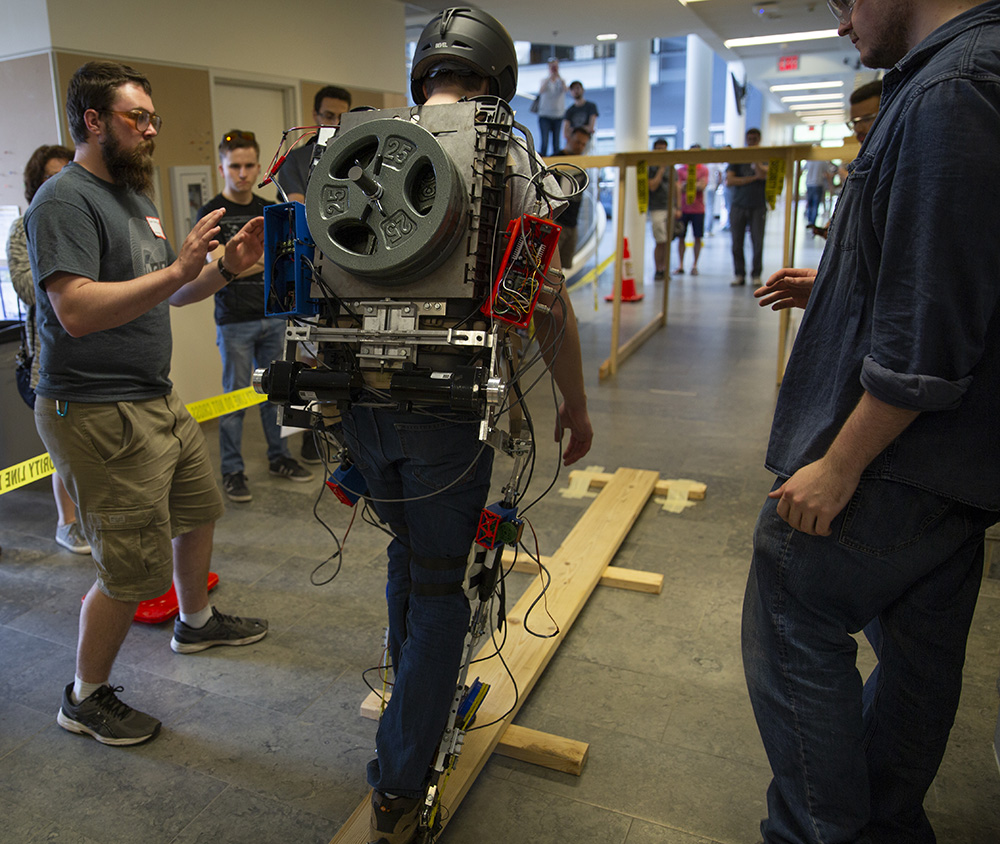
 Enlarge
EnlargeMechanical Engineering undergraduate student Leo McManus completes one of the obstacle course challenges, the balancing board, for the Applied Collegiate Exoskeleton Competition held inside the Bob & Betty Beyster Building on Saturday May 5, 2018 in Ann Arbor, MI. Photo by Robert Coelius/Michigan Engineering, Communications and Marketing
×
Despite the competition and teams’ youth, the enthusiasm for the technology brought several attendees. Michigan State’s STARX exoskeleton team, in its first year, brought 30 members to the competition.
Kevin Rabideau (BSE CS 2016) founded U-M’s STARX team three years ago. “I started the group to develop practical exoskeletons for giving extra strength and making loads lighter,” Rabideau said. “This is exactly what I was hoping for, to walk into a room with all these people making fantastic machines that make you stronger.”
Jessica Mosier, a junior studying mechanical engineering who led the organization of the competition, noted the high level of collaboration between teams and sharing ideas for improvements. “Everyone is so happy to be here and wants to see this type of event more often,” she said.
Creating the suits, however, is an endeavor, and many teams ran into trouble building a device that had all components working. “I’d estimate it took 1,200 hours to build our exoskeleton so far,” said Leo McManus, a U-M junior studying mechanical engineering and the team’s mechanical lead.
“We just kept running into issue after issue with the electronics, and only got them sorted out at 4 a.m. last night,” said Owen Winship, U-M STARX team member and computer engineering student.
Out of the five teams, three were able to put forward a functioning exoskeleton to compete. “Even if a team doesn’t have a suit here today to test with, they’re still excited to fix things that went wrong, make improvements, and come again next year,” said Rabideau.
The exoskeletons were put through tests similar to those for entry-level firefighters. After a design review, where safety components and how long it took to suit up were assessed, the exoskeletons were fitted with 75 pounds of weights and timed while moving through an obstacle course: on balance beam, up and down stairs, across uneven terrain, under a low-clearance beam, and dragging a 165-pound mannequin for 100 feet.
Judges for the event included Jessy Grizzle, Elmer G. Gilbert Distinguished University Professor and Director of Michigan Robotics, Deanna Gates, Director of the Rehabilitation Biomechanics Laboratory and assistant professor of kinesiology, Mike Kennedy, Ann Arbor Fire Department’s Fire Chief, and Dragi Gasevski, an engineer at Altair.
Colorado School of Mines won the overall competition, edging out the U-M host team by less than a tenth of a point on a 650-point scale. MSU took third place.
Mosier says the U-M team plans to host the event again next year.
“Despite everything going wrong and everything going to pieces, as every engineering project ever has, everything pulled through in the end and we saw really great performance out of every exoskeleton,” Winship said. “All we need to do is to do it again, and again, and again.”
Photo Gallery
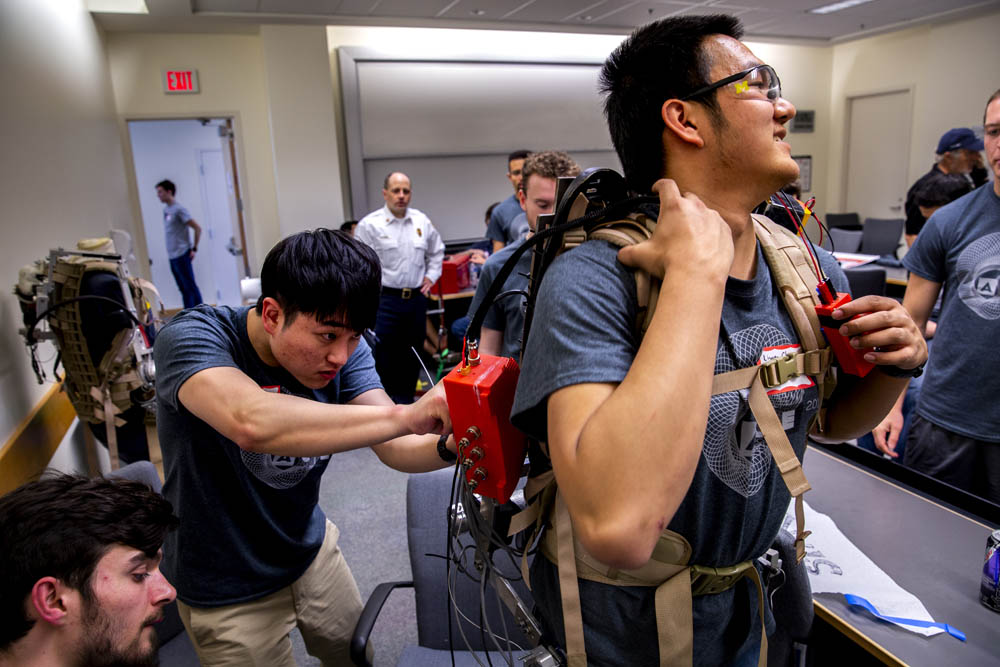 Electrical Engineering and Computer Science Undergraduate Student Jaehwan Lee makes last minute repairs to the exoskeleton built by the STrength Augmenting Robotic eXoskeleton (SPARX) Team as Mechanical Engineering Undergraduate Liwen Chen waits for the Applied Collegiate Exoskeleton Competition to begin inside the Bob & Betty Beyster Building on Saturday May 5, 2018 in Ann Arbor, MI.
The first ever collegiate competition brought five teams together to test the designs and overall effectiveness of their robotic exoskeletons.
Photo by Robert Coelius/ Michigan Engineering, Communications and Marketing
Electrical Engineering and Computer Science Undergraduate Student Jaehwan Lee makes last minute repairs to the exoskeleton built by the STrength Augmenting Robotic eXoskeleton (SPARX) Team as Mechanical Engineering Undergraduate Liwen Chen waits for the Applied Collegiate Exoskeleton Competition to begin inside the Bob & Betty Beyster Building on Saturday May 5, 2018 in Ann Arbor, MI.
The first ever collegiate competition brought five teams together to test the designs and overall effectiveness of their robotic exoskeletons.
Photo by Robert Coelius/ Michigan Engineering, Communications and Marketing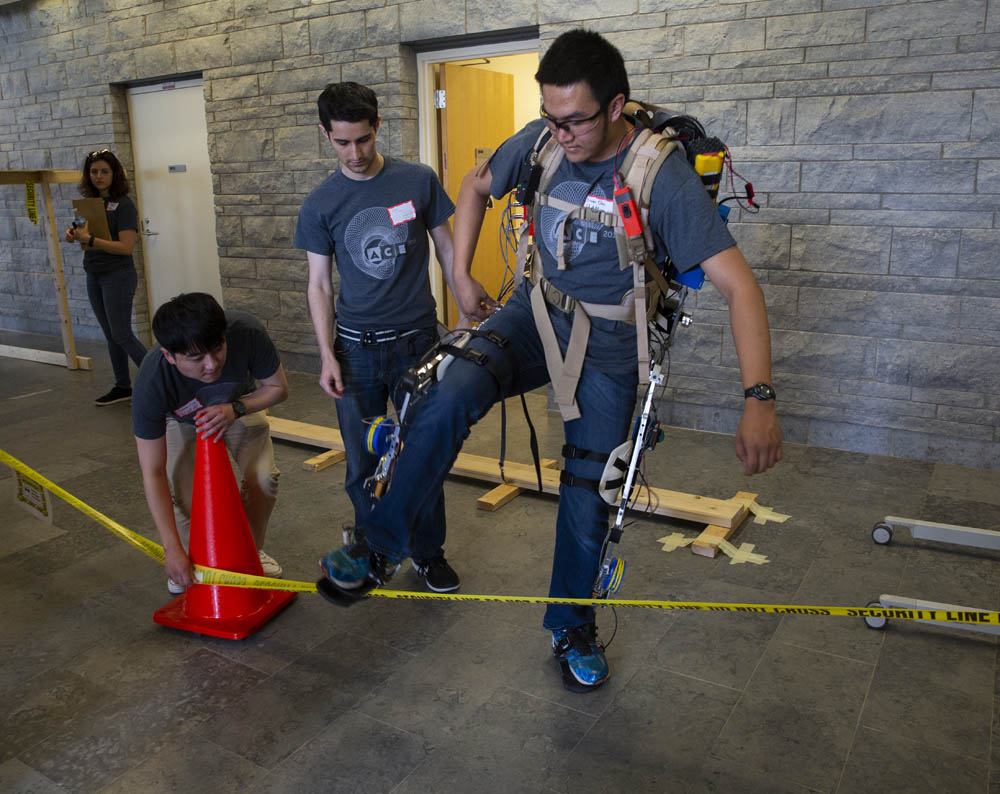 Mechanical Engineering Undergraduate Student Liwen Chen crosses over the protective barrier into the obstacle course wearing the exoskeleton built by the University of Michigan STrength Augmenting Robotic eXoskeleton (SPARX) Team at the Applied Collegiate Exoskeleton Competition inside the Bob & Betty Beyster Building on Saturday May 5, 2018 in Ann Arbor, MI.
The first ever collegiate competition brought five teams together to test the designs and overall effectiveness of their robotic exoskeletons.
Photo by Robert Coelius/ Michigan Engineering, Communications and Marketing
Mechanical Engineering Undergraduate Student Liwen Chen crosses over the protective barrier into the obstacle course wearing the exoskeleton built by the University of Michigan STrength Augmenting Robotic eXoskeleton (SPARX) Team at the Applied Collegiate Exoskeleton Competition inside the Bob & Betty Beyster Building on Saturday May 5, 2018 in Ann Arbor, MI.
The first ever collegiate competition brought five teams together to test the designs and overall effectiveness of their robotic exoskeletons.
Photo by Robert Coelius/ Michigan Engineering, Communications and Marketing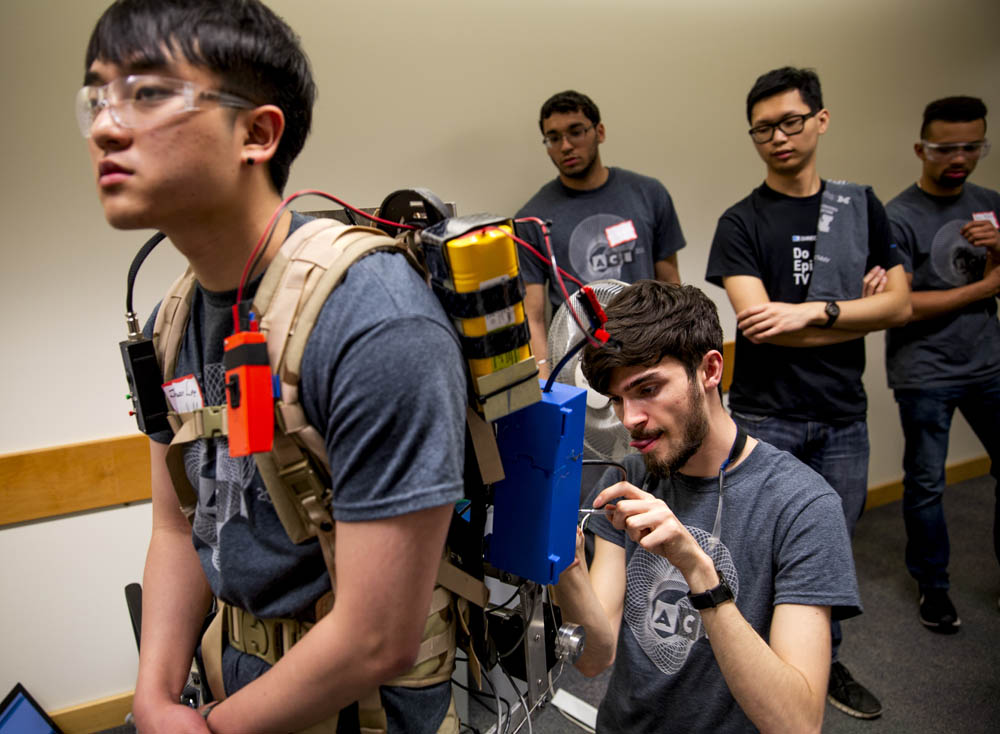 Electrical Engineering and Computer Science Undergraduate Engineering Student Owen Winship makes last minute repairs to the exoskeleton built by the STrength Augmenting Robotic eXoskeleton (SPARX) Team as Jaehwan Lee, another Electrical Engineering and Computer Sciences Undergraduate, waits for the Applied Collegiate Exoskeleton Competition to begin inside the Bob & Betty Beyster Building on Saturday May 5, 2018 in Ann Arbor, MI.
The first ever collegiate competition brought five teams together to test the designs and overall effectiveness of their robotic exoskeletons.
Photo by Robert Coelius/ Michigan Engineering, Communications and Marketing
Electrical Engineering and Computer Science Undergraduate Engineering Student Owen Winship makes last minute repairs to the exoskeleton built by the STrength Augmenting Robotic eXoskeleton (SPARX) Team as Jaehwan Lee, another Electrical Engineering and Computer Sciences Undergraduate, waits for the Applied Collegiate Exoskeleton Competition to begin inside the Bob & Betty Beyster Building on Saturday May 5, 2018 in Ann Arbor, MI.
The first ever collegiate competition brought five teams together to test the designs and overall effectiveness of their robotic exoskeletons.
Photo by Robert Coelius/ Michigan Engineering, Communications and Marketing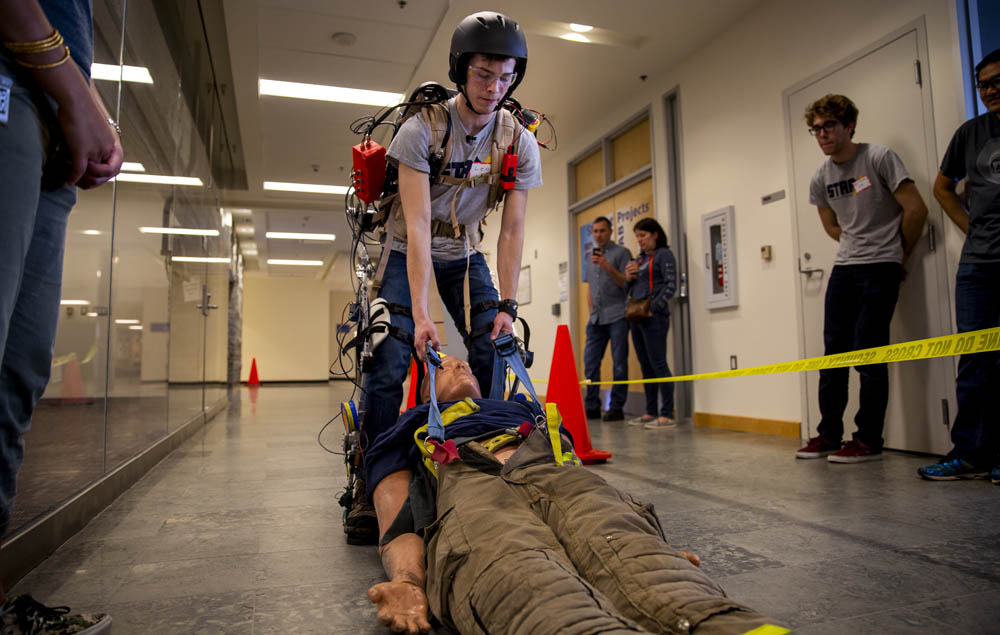 Mechanical Engineering Undergraduate Student Leo McManus completes the first obstacle course,dragging a 150 lb. firefighter simulation dummy, for the Applied Collegiate Exoskeleton Competition held inside the Bob & Betty Beyster Building on Saturday May 5, 2018 in Ann Arbor, MI.
The first ever collegiate competition brought five teams together to test the designs and overall effectiveness of their robotic exoskeletons.
Photo by Robert Coelius/ Michigan Engineering, Communications and Marketing
Mechanical Engineering Undergraduate Student Leo McManus completes the first obstacle course,dragging a 150 lb. firefighter simulation dummy, for the Applied Collegiate Exoskeleton Competition held inside the Bob & Betty Beyster Building on Saturday May 5, 2018 in Ann Arbor, MI.
The first ever collegiate competition brought five teams together to test the designs and overall effectiveness of their robotic exoskeletons.
Photo by Robert Coelius/ Michigan Engineering, Communications and Marketing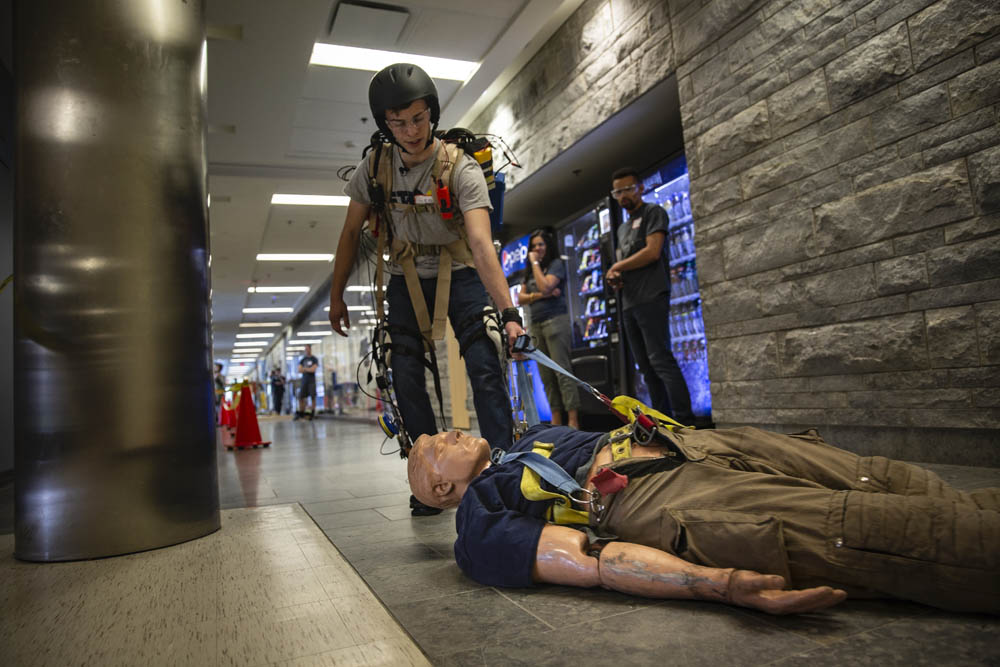 Mechanical Engineering Undergraduate Student Leo McManus competes in the first obstacle course,dragging a 150 lb. firefighter simulation dummy, at the Applied Collegiate Exoskeleton Competition held inside the Bob & Betty Beyster Building on Saturday May 5, 2018 in Ann Arbor, MI.
The first ever collegiate competition brought five teams together to test the designs and overall effectiveness of their robotic exoskeletons.
Photo by Robert Coelius/ Michigan Engineering, Communications and Marketing
Mechanical Engineering Undergraduate Student Leo McManus competes in the first obstacle course,dragging a 150 lb. firefighter simulation dummy, at the Applied Collegiate Exoskeleton Competition held inside the Bob & Betty Beyster Building on Saturday May 5, 2018 in Ann Arbor, MI.
The first ever collegiate competition brought five teams together to test the designs and overall effectiveness of their robotic exoskeletons.
Photo by Robert Coelius/ Michigan Engineering, Communications and Marketing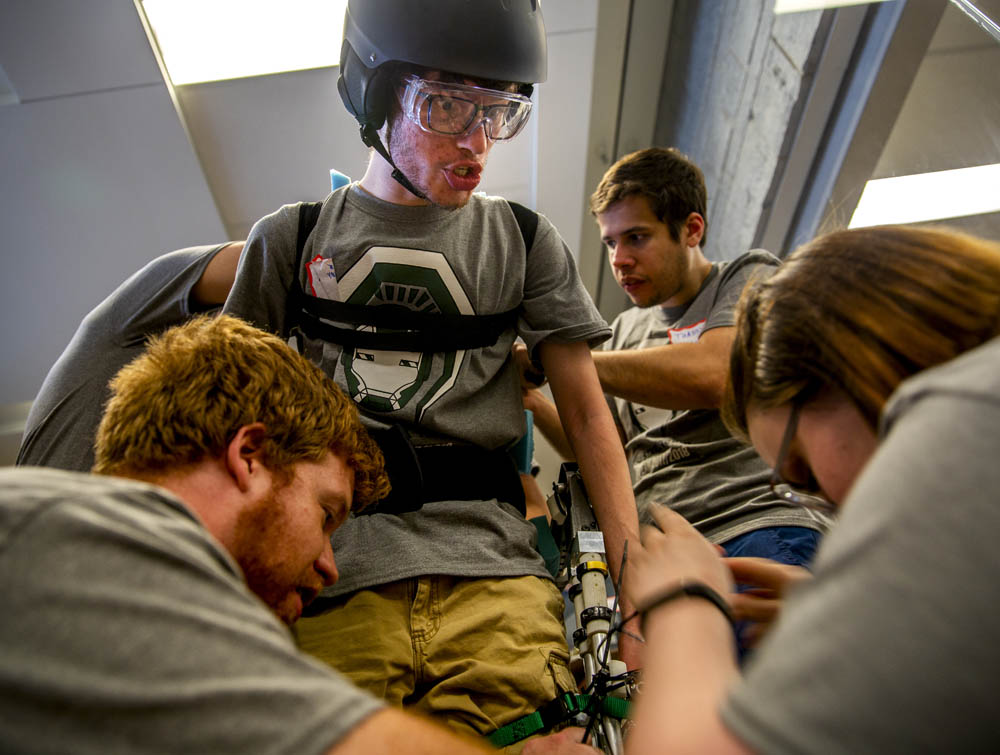 Members of the Michigan State STrength Augmenting Robotic eXoskeleton (SPARX) Team make some last minute repairs before the obstacle course at the Applied Collegiate Exoskeleton Competition held inside the Bob & Betty Beyster Building on Saturday May 5, 2018 in Ann Arbor, MI.
The first ever collegiate competition brought five teams together to test the designs and overall effectiveness of their robotic exoskeletons.
Photo by Robert Coelius/ Michigan Engineering, Communications and Marketing
Members of the Michigan State STrength Augmenting Robotic eXoskeleton (SPARX) Team make some last minute repairs before the obstacle course at the Applied Collegiate Exoskeleton Competition held inside the Bob & Betty Beyster Building on Saturday May 5, 2018 in Ann Arbor, MI.
The first ever collegiate competition brought five teams together to test the designs and overall effectiveness of their robotic exoskeletons.
Photo by Robert Coelius/ Michigan Engineering, Communications and Marketing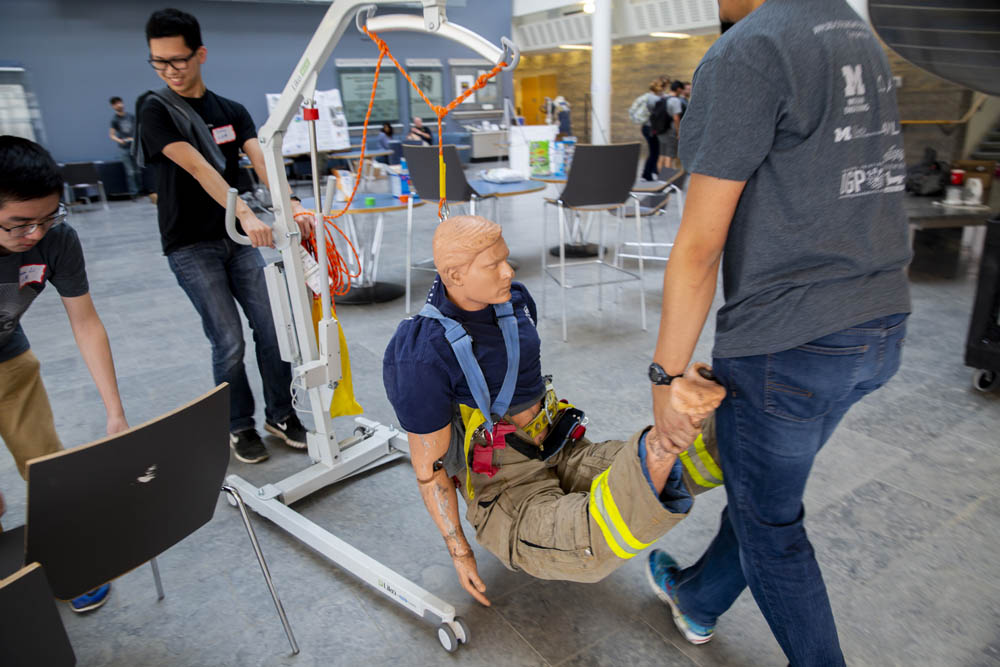 Undergraduate Engineering Students from the STrength Augmenting Robotic eXoskeleton (STARX) Team carry a 150 lb. firefighter simulation dummy for the Applied Collegiate Exoskeleton Competition held inside the Bob & Betty Beyster Building on Saturday May 5, 2018 in Ann Arbor, MI.
The first ever collegiate competition brought five teams together to test the designs and overall effectiveness of their robotic exoskeletons.
Photo by Robert Coelius/ Michigan Engineering, Communications and Marketing
Undergraduate Engineering Students from the STrength Augmenting Robotic eXoskeleton (STARX) Team carry a 150 lb. firefighter simulation dummy for the Applied Collegiate Exoskeleton Competition held inside the Bob & Betty Beyster Building on Saturday May 5, 2018 in Ann Arbor, MI.
The first ever collegiate competition brought five teams together to test the designs and overall effectiveness of their robotic exoskeletons.
Photo by Robert Coelius/ Michigan Engineering, Communications and Marketing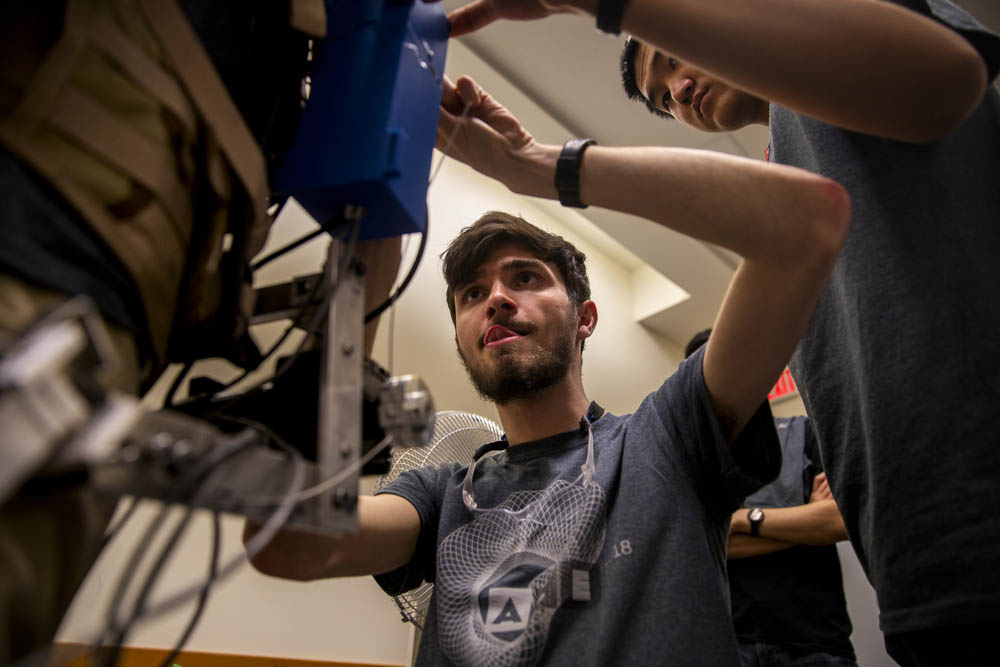 Electrical Engineering and Computer Science Undergraduate Engineering Student Owen Winship makes last minute repairs to the exoskeleton built by the STrength Augmenting Robotic eXoskeleton (SPARX) Team for the Applied Collegiate Exoskeleton Competition held inside the Bob & Betty Beyster Building on Saturday May 5, 2018 in Ann Arbor, MI.
The first ever collegiate competition brought five teams together to test the designs and overall effectiveness of their robotic exoskeletons.
Photo by Robert Coelius/ Michigan Engineering, Communications and Marketing
Electrical Engineering and Computer Science Undergraduate Engineering Student Owen Winship makes last minute repairs to the exoskeleton built by the STrength Augmenting Robotic eXoskeleton (SPARX) Team for the Applied Collegiate Exoskeleton Competition held inside the Bob & Betty Beyster Building on Saturday May 5, 2018 in Ann Arbor, MI.
The first ever collegiate competition brought five teams together to test the designs and overall effectiveness of their robotic exoskeletons.
Photo by Robert Coelius/ Michigan Engineering, Communications and Marketing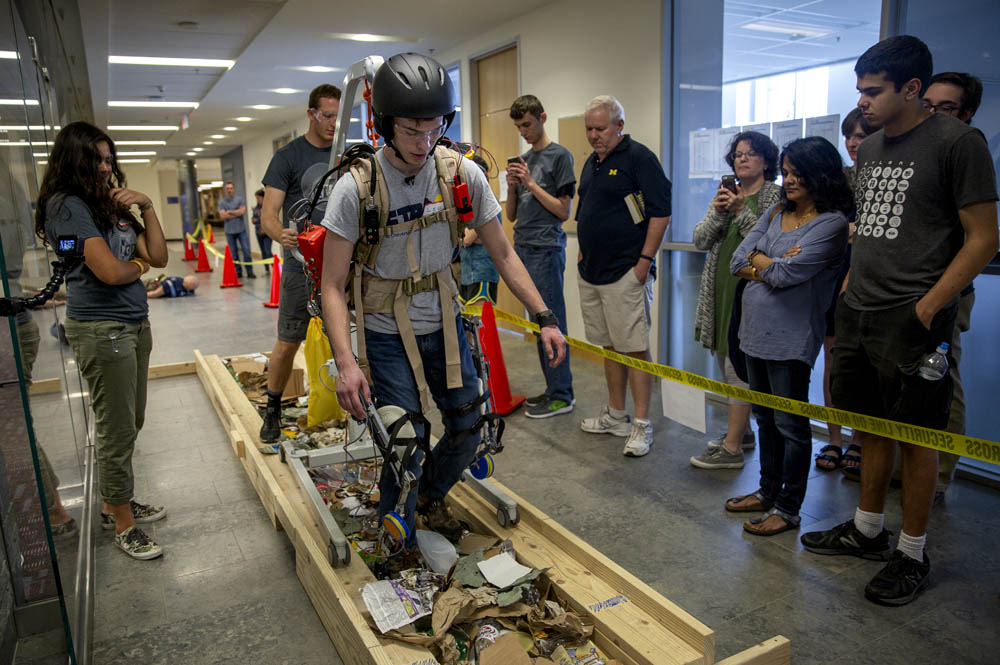 Mechanical Engineering Undergraduate Student Leo McManus completes one of the five obstacle course challenges, the Rubble Field, for the Applied Collegiate Exoskeleton Competition held inside the Bob & Betty Beyster Building on Saturday May 5, 2018 in Ann Arbor, MI.
The first ever collegiate competition brought five teams together to test the designs and overall effectiveness of their robotic exoskeletons.
Photo by Robert Coelius/ Michigan Engineering, Communications and Marketing
Mechanical Engineering Undergraduate Student Leo McManus completes one of the five obstacle course challenges, the Rubble Field, for the Applied Collegiate Exoskeleton Competition held inside the Bob & Betty Beyster Building on Saturday May 5, 2018 in Ann Arbor, MI.
The first ever collegiate competition brought five teams together to test the designs and overall effectiveness of their robotic exoskeletons.
Photo by Robert Coelius/ Michigan Engineering, Communications and Marketing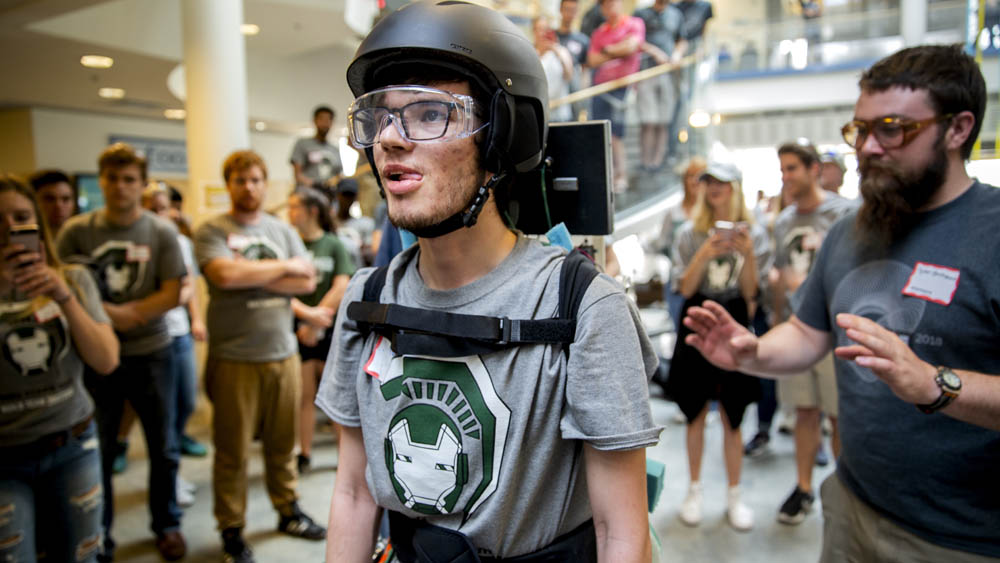 A member of the Michigan State STrength Augmenting Robotic eXoskeleton (SPARX) Team waits his turn at the obstacle course at the Applied Collegiate Exoskeleton Competition held inside the Bob & Betty Beyster Building on Saturday May 5, 2018.
The first ever collegiate competition brought five teams together to test the designs and overall effectiveness of their robotic exoskeletons.
Photo by Robert Coelius/ Michigan Engineering, Communications and Marketing
A member of the Michigan State STrength Augmenting Robotic eXoskeleton (SPARX) Team waits his turn at the obstacle course at the Applied Collegiate Exoskeleton Competition held inside the Bob & Betty Beyster Building on Saturday May 5, 2018.
The first ever collegiate competition brought five teams together to test the designs and overall effectiveness of their robotic exoskeletons.
Photo by Robert Coelius/ Michigan Engineering, Communications and Marketing

 Enlarge
Enlarge










 MENU
MENU 
